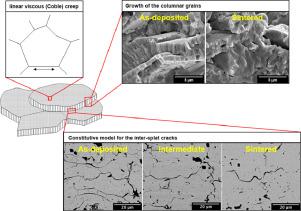Acta Materialia ( IF 9.4 ) Pub Date : 2021-01-15 , DOI: 10.1016/j.actamat.2021.116649 Xun Zhang , Alan C.F. Cocks , Yoshifumi Okajima , Kazuma Takeno , Taiji Torigoe

|
A micromechanical model is developed to predict microstructure evolution and the resultant in-plane modulus increase in a thermal barrier coating (TBC) manufactured by air plasma spray (APS). The model is based on the experimental observation that the main sintering events include the progressive healing of the inter-splat cracks and the coarsening of the columnar grains within the splats. During sintering, the splats undergo Coble creep, which relaxes the constraint on crack healing and therefore sintering. Given its columnar structure, the creep response of the splats is taken to be transversely isotropic. The proposed model is implemented numerically using finite element (FE) meshes that have been developed from cross-sectional micrographs of an as-deposited coating. This allows the evolution of microstructural features directly relevant to the performance of TBCs to be modelled, from which the overall elastic response can also be determined. The curvy nature of the nearly horizontal inter-splat cracks and the intersecting vertical intra-splat cracks explain the low in-plane modulus of the as-deposited TBC and their healing explains the evolution of in-plane modulus during sintering. The model results are validated by comparison with sintering experiments, in terms of the evolution of crack patterns and in-plane modulus. The sensitivity of the model results to the major geometrical parameters is explored and summarised in the form of a sintering map, which identifies the controlling processes as a function of the microstructural and kinetic properties. Finally, the effect of constraint on the overall sintering response is investigated.
中文翻译:

基于图像的空气等离子喷涂热障涂层烧结模型
建立了微机械模型,以预测通过空气等离子喷涂(APS)制造的热障涂层(TBC)的微观结构演变和所得的面内模量增加。该模型基于实验观察,主要的烧结事件包括板间裂纹的逐步修复和板内柱状晶粒的粗化。在烧结过程中,这些板片会经历Coble蠕变,从而放松了对裂纹愈合和烧结的限制。给定其圆柱状结构,其蠕变响应被认为是横向各向同性的。所提出的模型是使用有限元(FE)网格在数字上实现的,该网格是根据沉积涂层的横截面显微照片开发的。这使得可以模拟与TBC的性能直接相关的微观结构特征的演变,从中还可以确定总体弹性响应。近似水平的板间裂纹和相交的垂直板内裂纹的弯曲特性解释了沉积态TBC的低平面模量,其愈合解释了烧结过程中平面模量的演变。通过与烧结实验比较,在裂纹图案和面内模量的演变方面验证了模型结果。以烧结图的形式探索和总结了模型结果对主要几何参数的敏感性,该图确定了控制过程与微观结构和动力学特性之间的关系。最后,



























 京公网安备 11010802027423号
京公网安备 11010802027423号